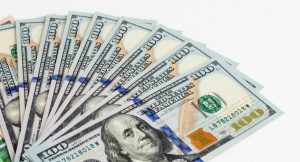DOLLAR FALLS AFTER DATA DISAPPOINTS; TRUMP CALLS FOR RATE CUT
The dollar fell across the board on Wednesday after weaker-than-expected U.S. private payrolls numbers highlighted continued easing in the labor market and data showed the U.S. services sector contracted for the first time in about a year in May. U.S. private payrolls rose by only 37,000 jobs in May, far less than expected, after a downwardly revised 60,000 rise in April, the ADP National Employment Report showed on Wednesday. Economists polled by Reuters had forecast private employment increasing 110,000 following a previously reported gain of 62,000 in April. U.S. President Donald Trump reiterated his calls for Federal Reserve Chair Jerome Powell to lower interest rates following the data. “It’s a major gap between expectation and actual,” Juan Perez, director of trading at Monex USA in Washington. “This idea that labor has not been hurt and that the post-pandemic recovery was good enough that people are enjoying good opportunities … that narrative is changing and that’s absolutely very negative for the U.S. dollar,” he said. Separately, data showed the U.S. services sector contracted for the first time in nearly a year in May while businesses paid higher prices for inputs, a reminder that the economy remained in danger of a period of very slow growth and high inflation. “The Fed will take notice of slower job growth, but this won’t be enough to convince them to cut interest rates near term,” Bill Adams, chief economist for Comerica Bank, said in a note. The dollar fell 0.7% to 142.89 Japanese yen. The euro rose 0.4% to $1.1414, ahead of the European Central Bank’s decision on interest rates expected on Thursday. Investors are awaiting Friday’s monthly payrolls figures to gauge the state of the labor market, and remain focused on trade negotiations. The Trump administration has given a Wednesday deadline for countries to submit their best offers on trade, the same day duties on imported steel and aluminium doubled. Trump is also tipped by the White House to have a call this week with Chinese President Xi Jinping, after the two sides accused each other of violating the terms of an agreement last month to roll back some tariffs. Trump posted on his social media platform on Wednesday that Xi was “tough” and “hard to make a deal with.” The dollar index, which measures the greenback against six major currencies, was 0.3% lower on the day at 98.838, not far from its late-April low of 97.923. The Hong Kong dollar was at 7.847 per U.S. dollar, the closest it has been to 7.85 – the weak end of its trading band against the U.S. dollar – since August 2023, according to LSEG data. Sterling was 0.2% higher at $1.35515. The UK and its metal exports are exempt from the increased U.S. duties, given Britain has a trade deal in place. Traders were also monitoring developments in Japanese markets after sources told that the Bank of Japan is considering slowing down the tapering in its bond purchases from next fiscal year onward. The Canadian dollar was about 0.4% higher versus its U.S. peer after the Bank of Canada on Wednesday held its key benchmark rate at 2.75%, citing the need to probe the effects of U.S. trade policy. “Canada is prepared to strike back if talks with Washington to remove Trump’s tariffs did not succeed”, Prime Minister Mark Carney said on Wednesday. Bitcoin, the world’s largest cryptocurrency by market capitalization, was 0.7% lower at $105,064.
DOLLAR TO DECLINE FURTHER ON U.S. FISCAL, GROWTH AND TRADE RISKS: REUTERS POLL
BENGALURU, June 4 (Reuters) – Falling demand for U.S. dollar-denominated assets will push the greenback lower in coming months, according to FX strategists surveyed by Reuters, as concerns mount about the U.S. federal deficit and debt. U.S. President Donald Trump’s erratic tariff policies, along with the House of Representatives recently passing a tax-cut and spending bill that would add $3.3 trillion to an already-enormous $36.2 trillion debt pile, have many investors worried. Long-term bond yields have soared on a rising ‘term premium’ – compensation for holding longer-duration debt – leading to swathes of asset outflows and a near-10% fall in the dollar against a basket of major currencies (.DXY), opens new tab since mid-January. Its usual close relationship with 10-year Treasury yields has also broken down. Asked what would happen to demand for dollar-denominated assets in a May 30-June 4 poll, a near-90% majority, 59 of 66 FX strategists, said it would decline. “It’s quite evident right now there is a ‘sell-America’ trade playing out, and how much dollar demand decreases depends on the extent to which U.S. growth is perceived to be hit by the current policies of the administration,” said Jane Foley, head of FX strategy at Rabobank. “If the market is still anticipating the growth outlook will be undermined, the trend will be towards further dollar losses over the medium-term.” Over 55% of analysts in a May Reuters poll also expressed concern about the dollar’s ‘safe haven’ status, up from only around one-third in April. This month, over half of respondents upgraded their euro forecasts. The common currency, currently $1.14, was predicted to hold steady in three months, gain about 1% to $1.15 in six and about a further 3% to $1.18 in a year. Euro-dollar median forecasts recorded in the survey were the highest since November 2021. Only just in February, around one-third were expecting it to reach parity within a year. But most of that has to do with the outlook for the dollar. A series of interest rate cuts this year from the European Central Bank while the Federal Reserve has stayed on hold would normally generate the opposite result on interest rate differentials. “Over the summer, we’re expecting (U.S.) term premium risks on elevated fiscal concerns and hard labor market data starting to turn. That is a very negative combination for the dollar,” said Dan Tobon, head of G10 FX strategy at Citi. “Our…target on euro-dollar has been $1.15, but we think it can get to $1.20. And that might happen sooner than we’re expecting if these catalysts do play out.” Asked how a thinning dollar trade would evolve by end-June, half the strategists, 21 of 42, said there would not be much change from speculators’ current net-short position. Nineteen said there would be an increase in net-shorts, while two said decrease. Asked which region would benefit the most from sustained dollar outflows, respondents mostly said Europe. Despite a slight souring of sentiment owing to the Trump-led trade war, investors are still generally optimistic that infrastructure and defence spending plans, particularly in Germany, will revitalise the bloc’s long-sluggish economy. “When you talk to clients in the European area, they feel like there’s a lot more potential positive catalysts for growth there – not just because of the money that will be spent on defence and infrastructure – but because there’s belief that’s actually the beginning of a lot of other structural changes,” Citi’s Tobon added. Heightened uncertainty from rising U.S. inflation expectations – near their highest in at least four decades – has also effectively tied the Fed’s hands for the time being even though markets still expect two more cuts this year. The ECB is expected to cut this week and possibly once more.

STERLING EDGES UP, UK AVOIDS HIGHER US METALS TARIFFS
Sterling firmed against the dollar on Wednesday, as investors were relieved the United Kingdom was not in the crosshairs of U.S. President Donald Trump’s latest tariff escalation, while upbeat economic data also buoyed sentiment. The U.S. doubled duties on steel and aluminium imports to 50% but exempted the UK. Analysts were sceptical, however, about what room there might be to do away with the existing 25% duties through the agreement signed last month. “UK steel exports were supposed to incur no tariff, so Trump’s abrupt change may cause UK negotiators to question the value of ‘agreements’ made,” said Paul Donovan, chief economist at UBS Global Wealth Management. The mood among global investors was one of caution ahead of an anticipated call between Trump and his Chinese counterpart which could determine where the world’s two largest economies stand with regard to trade relations. Wednesday is also the deadline the Trump administration has given its trade partners to offer their best deals to avoid steep levies on goods imported into the U.S. The pound firmed 0.12% and was last at $1.353, while against the euro it was last flat and bought 84.11 pence by 0947 GMT. Sterling has outperformed the greenback alongside its developed market peers, including the euro and Swiss franc, as Trump’s erratic policies have encouraged investors to look outside the U.S. for opportunities and the UK is perceived to be better insulated from trade uncertainty. Tuesday’s gilt auctions also indicated strong investor demand for the country’s longer-dated bonds, a stark contrast to similar sales in the U.S. and Japan last month. Still, investors will closely monitor how Finance Minister Rachel Reeves goes about funding the government’s proposed infrastructure plans. Yields on 30-year and 40-year gilts were up about 2 basis points each on Wednesday. Meanwhile, a survey showed Britain’s services sector returned to tepid growth last month, with the Bank of England expecting deteriorating business confidence as a consequence of global uncertainty to weigh on growth in the coming months. Traders are pricing in that the central bank will lower borrowing costs by about 37 basis points by the end of this year, according to data compiled by LSEG.
DOLLAR MAKES TENTATIVE GAINS DESPITE WEAK DATA, EURO STEADY AHEAD OF ECB
SINGAPORE/LONDON – The euro steadied near six-week highs against the dollar ahead of an expected interest rate cut from the European Central Bank on Thursday, while the U.S. currency recovered modestly from a dip after data renewed fears of slow growth and high inflation. Data on Wednesday showed the U.S. services sector contracted for the first time in nearly a year in May, and also an easing labour market, leading to a rally in Treasuries and increasing the chances of more rate cuts from the Federal Reserve this year. “For most of the week, we’ve been staying in relatively tight ranges… there was dollar softness yesterday after the downside surprise in the ISM services data, but slightly calmer heads are prevailing this morning,” said Michael Brown, senior research strategist at Pepperstone. On Thursday, the dollar was up 0.37% against the yen at 143.34, and 0.25% higher against the Swiss franc at 0.82025 francs. Meanwhile, the euro was virtually unchanged at $1.1416, not far from a six-week high it touched at the start of the week. Sterling was flat at $1.3565. Brown said FX markets were essentially in a holding pattern until the European Central Bank decision later on Thursday, and ahead of closely-tracked U.S. May jobs report on Friday. The ECB is expected to cut its benchmark rate by a quarter of a point, marking the eighth reduction in 13 months as inflation eased from post-pandemic highs. The central bank is seeking to prop up a euro zone economy that was struggling even before the erratic economic and trade policies of U.S. President Donald Trump’s administration dealt it yet another blow. Commerzbank analysts said the ECB was likely to lower its growth and inflation forecasts for 2025 slightly and may mention the stronger euro, given its disinflationary effect. Data on Tuesday showed euro zone inflation easing below the ECB’s 2% target, supporting rate cut bets.

STERLING HOLDS ITS OWN AGAINST STRONGER DOLLAR, TRADE OPTIMISM LENDS SUPPORTS
Sterling ticked higher against the dollar on Thursday, one of the few major currencies to hold its own against the greenback which regained ground after weak U.S. data dragged it lower on Wednesday. The pound was up 0.14% at $1.3574, while against the euro it was up 0.1% at 84.16 pence. Sterling remains a touch away from a more than three-year high hit on May 26, underpinned by ongoing dollar weakness with the pound up over 8% this year. Also helping is the fact the UK is the only country to have struck a trade deal with the U.S and was spared from higher U.S. steel and aluminium tariffs, though analysts question how beneficial those factors are. “The trade deal does matter,” said Chris Beauchamp, chief market analyst at IG Group. “You might argue it’s not a proper trade deal and that it doesn’t solve all the problems, but at least it’s a sign that there’s a more compelling reason to hold the pound rather than be worrying about the euro,” Beauchamp added. The Bank of England (BoE) will meet on June 19 to deliver its next policy decision with market bets firmly on the monetary policy committee (MPC) keeping rates steady. There had been expectations of a further 25 bps cut from the BoE at its June meeting but bets were slashed following weak economic data and a hotter-than-expected inflation read last month. On Tuesday, Bank of England Governor Andrew Bailey said he was sticking with a “gradual and careful” approach to cutting interest rates as global trade policy turmoil increasingly clouds the outlook. Reassurance came on Wednesday with a survey showing Britain’s services sector returned to tepid growth last month.

- CAPITALDIGEST MARKET REVIEW , 03/11/2025November 3, 2025
- CAPITALDIGEST DAILY NEWS, 03/11/2025November 3, 2025
- CAPITALDIGEST MARKET REVIEW, 22/09/2025September 22, 2025
Enter your email address for receiving valuable newsletters.
- CAPITALDIGEST DAILY NEWS, 03/11/2025NNPCL WEIGHS OVERHAUL, REPURPOSING OPTIONS FOR REFINERIES The Nigerian National Petroleum Company Limited has said...November 3, 2025
- CAPITALDIGEST MARKET REVIEW, 22/09/2025STERLING RISES AGAINST DOLLAR ON FED-BOE POLICY DIVERGENCE Sterling gained against the dollar on Tuesday,...September 22, 2025
- CAPITALDIGEST DAILY NEWS, 22/09/2025OIL REFORMS DRIVE $18.2BN DEALS – FG Nigeria’s oil and gas sector is experiencing a...September 22, 2025












